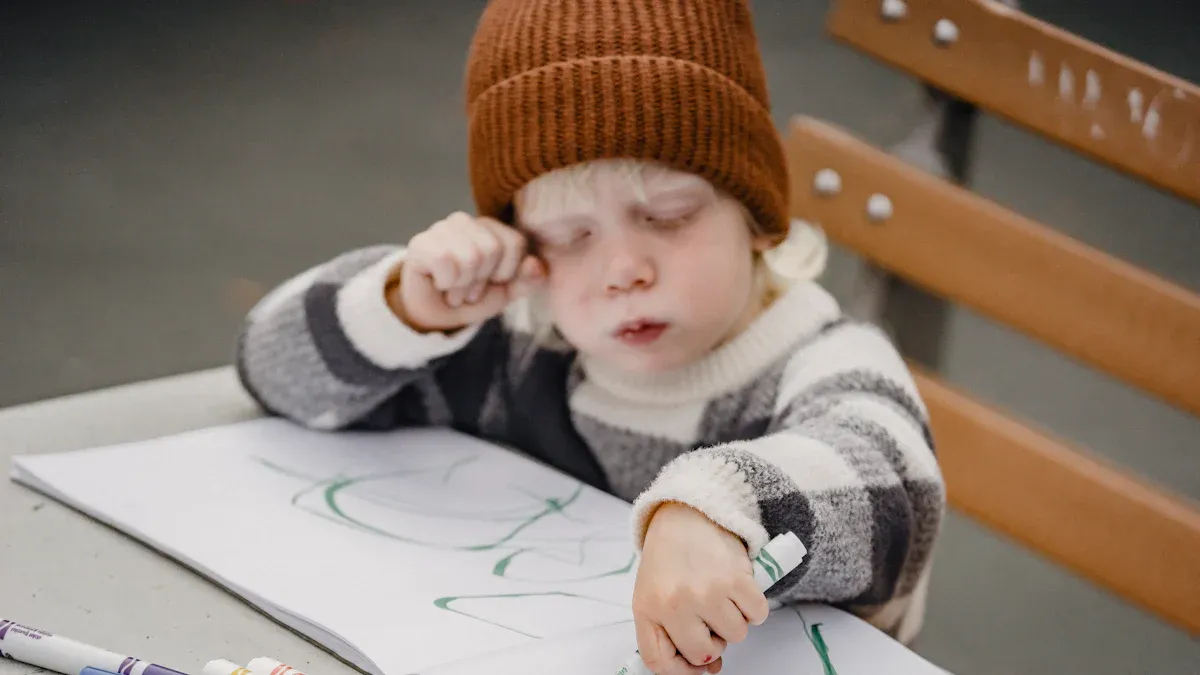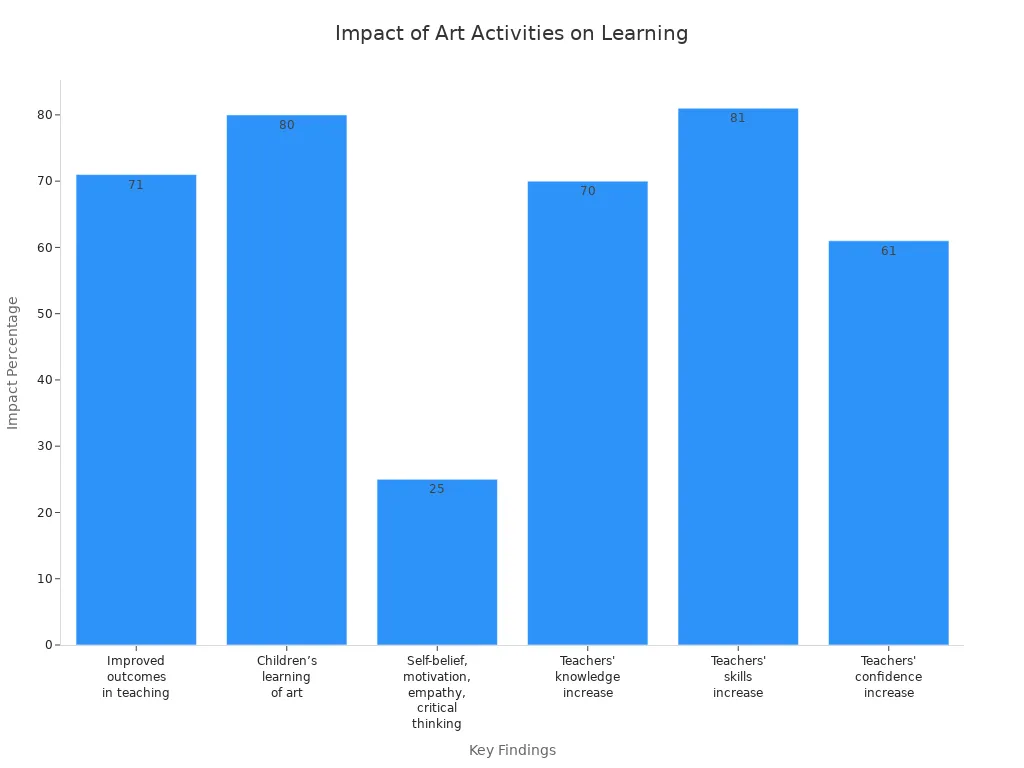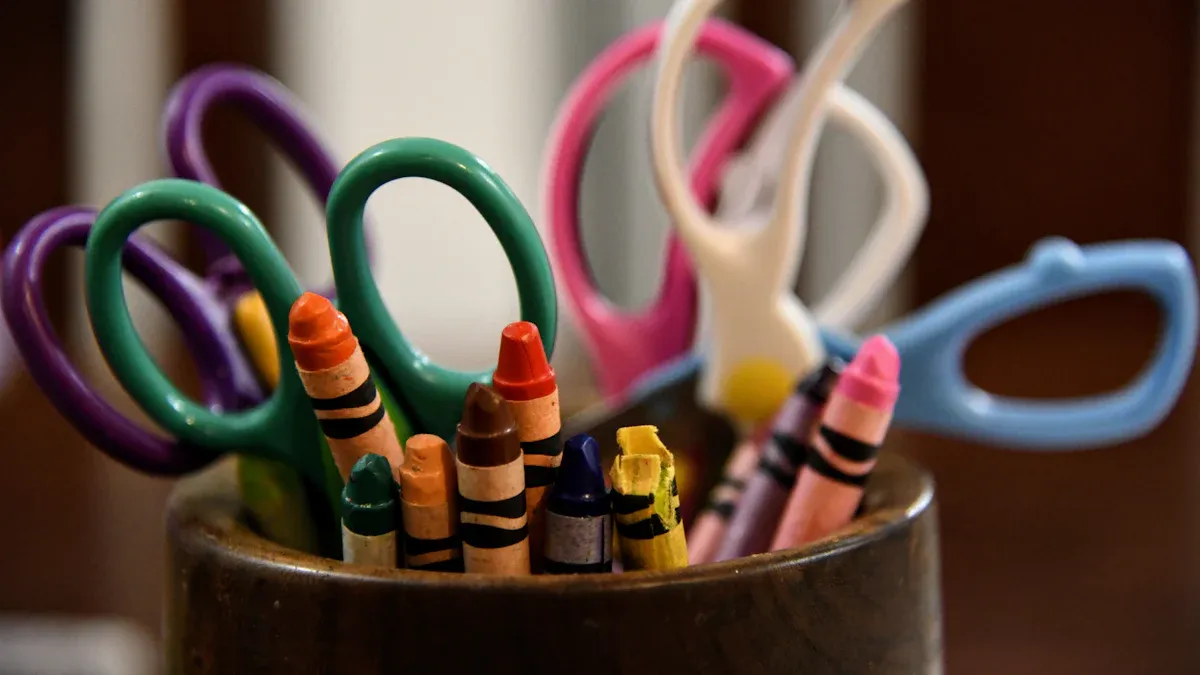You might wonder when your toddler start using markers. Most little ones enjoy early coloring with crayons at 12-15 months. Markers usually work best from 18 months, as long as you supervise. Every child grows at their own pace. Get ready to enjoy this colorful milestone together!
Key Takeaways
- Most toddlers can use markers at about 18 months old. Watch for signs like a steady hand and wanting to color.
- Always watch your toddler when they do art. This keeps them safe from bad things and stops big messes.
- Help your child be creative with easy art projects. Give them washable markers and praise their art to help them feel proud.
When Can My Toddler Start Using Markers?

Recommended Age Range
You probably notice your child loves to scribble as soon as they can hold a crayon. Most toddlers start coloring and making marks between 12 and 15 months. Markers, though, are a bit different. They can be messier and sometimes harder to control. Pediatric occupational therapists suggest that children usually begin to scribble with markers around 14 to 16 months. Still, most parents find that waiting until about 18 months works best, especially if you want to keep your walls and furniture safe.
Here’s a quick look at when kids usually start using different art supplies:
| Activity | Age Range |
|---|---|
| Scribbles with marker | 14 to 16 months |
If you wonder when your toddler start using markers, remember that every child is unique. Some kids show interest earlier, while others take a little longer. Watch for signs like a steady grip, curiosity about drawing, and the ability to follow simple directions. These clues help you know when your toddler start using markers safely and happily.
Why Supervision Matters
Markers can open up a world of creativity, but they also come with a few risks. You want to make sure your child stays safe while having fun. Here’s why you should always supervise your toddler during art time:
- Some markers contain chemicals or pigments that can be harmful if swallowed or smeared on skin.
- Young children are more sensitive to these substances than adults.
- It’s hard to know exactly how much time kids spend with art supplies, so it’s better to be cautious.
- Cleaning up and washing hands after art time helps keep everyone safe.
- Safe storage keeps markers out of reach when you’re not around.
Tip: Always supervise your toddler when they use markers. Keep art supplies in a secure spot and teach your child to wash their hands after drawing.
When you supervise your toddler, you help them learn how to use markers the right way. You also protect them from accidents, like drawing on the walls or putting markers in their mouth. With a little guidance, art time becomes a safe and joyful experience for everyone.
Ready to Start Coloring
Developmental Signs
You might wonder how to tell if your toddler is ready to start coloring. Every child grows at their own pace, but some signs can help you know when it’s time to bring out the markers. Most toddlers show interest in coloring, even if they only color for a few minutes at first. You may notice your child tapping or making big marks on paper. They often grab crayons or markers with their whole hand. Sometimes, they even put art supplies in their mouth, so you need to keep a close eye on them.
Here’s a quick table to help you spot these early signs:
| Developmental Sign | Description |
|---|---|
| Interest in coloring | Shows curiosity about coloring, even if just for a short time. |
| Brief coloring sessions | Colors for a few minutes, focusing on the process, not the result. |
| Tapping and scribbling | Makes big marks or taps on the paper, using arm movements. |
| Grasping the crayon | Holds crayons or markers with their whole hand (palmar supinate grasp). |
| Mouthing objects | Puts crayons or markers in their mouth, which is common at this age. |
Fine Motor Skills
Fine motor development plays a big role in coloring. At first, your toddler uses their whole arm to draw. Over time, you’ll see more control as they start using their fingers. Most children begin controlled scribbling between ages 2 and 3. You might notice your child drawing lines or circles, showing better hand-eye coordination.
Here are some typical milestones:
- Imitates drawing movements with the whole arm.
- Makes basic scribbles.
- Shifts to using finger movements for more control.
- Imitates lines and circles.
- Manipulates small objects like beads or coins.
When you see these signs, you’ll know your child is ready to start coloring with markers and explore their creativity.
What to Expect
First Experiences
When you hand your toddler a marker for the first time, you might see a mix of excitement and curiosity. Your child may grip the marker with their whole hand and make big, sweeping marks across the paper. Sometimes, the marks end up on their hands or even the table. This is all part of the learning process.
You can expect your toddler to:
- Explore how the marker feels and looks on different surfaces.
- Try out different colors, often switching quickly from one to another.
- Make simple shapes or just random scribbles.
- Sometimes describe what they are drawing, even if it looks like a jumble to you.
Tip: Keep plenty of paper handy and dress your child in clothes you don’t mind getting messy. This helps you relax and lets your child focus on having fun.
Learning Through Art
Art time is more than just play. When your toddler uses markers, they build important skills for life. Here’s what your child gains from these creative moments:
- Learns about colors and shapes, which boosts thinking skills.
- Develops fine motor skills by gripping and moving the marker.
- Expresses feelings and ideas, even before they can say them in words.
- Builds confidence and independence by making choices in their artwork.
- Practices problem-solving and critical thinking as they decide what to draw.

As your child grows, you’ll notice their drawings change from simple lines to more detailed pictures. This shows real growth in how they think and see the world. Art also gives your child a way to share stories and ideas, helping language skills develop along the way.
Marker Safety
Choosing the Right Markers
Safety is the most important thing when picking markers. You want your toddler to make art without danger. Always choose markers that say non-toxic on the label. Little kids often put things in their mouths. That means you should avoid markers with bad chemicals like xylene, toluene, lead, heavy metals, phthalates, or formaldehyde. The American Academy of Pediatrics says safe art supplies keep kids away from toxic stuff.
You can look for these safety labels on marker packages:
| Certification | Description |
|---|---|
| ASTM D-4236 | Product has passed tough safety tests and is non-toxic. |
| ACMI AP | Product is checked by experts and is safe for kids. |
Some companies care a lot about safety. Here are some brands you might find:
| Marker Brand | Features |
|---|---|
| Faber-Castell | Big markers, caps with holes, food-safe dyes, easy to wash off. |
| Mondo Llama | Water-based markers, easy to buy at Target. |
| Crayola | Markers that wash out easily and are safe. |
| Cra-Z-Art | Markers that are super washable and non-toxic. |
| Arteza | Dry erase markers that do not smell much and are safe. |
Tip: Washable markers help you clean up fast and keep your house neat!
Safe Storage
Keep markers away from your toddler when not in use. Put markers and pens in boxes with tight lids. Store them high up or in a locked drawer. Make sure everyone who watches your child knows where to put art supplies.
- Keep markers where kids cannot reach them.
- Use boxes with lids that close tight.
- Tell all caregivers your storage rules.
If you want to organize art stuff, use clear bins or jars. This helps you and your child see what is inside. Put labels on each box, and if your child cannot read, use pictures. This helps your toddler know where things go and keeps art time safe and fun.
Encouraging Creativity
Simple Art Ideas
You want your toddler to have fun with art. Simple art activities can help your child be creative. Try using different markers and art tools at home.
| Art Activity | Description |
|---|---|
| Washable Markers | Great for toddlers, these are easy to clean and stop messes. |
| Dot Markers | Bright and mess-free, these are easy for toddlers to use. |
| Tempera Paint Sticks | Work like glue sticks and give bright colors on paper. |
Let your child draw shapes or make dots and patterns. These activities help your child learn about colors and textures. You might see your toddler use their imagination to make stories from scribbles. If you want more structure, try short art lessons. Focus on one tool or color each time.
Art time is not just for passing time. It helps your child build fine motor skills and creativity. Art also helps your child solve problems. You give your child a way to show feelings and grow confidence.
Positive Reinforcement
Encouragement helps your toddler try new things. Positive reinforcement makes your child feel proud and want to keep making art. You can use a reward chart to track progress and celebrate wins.
| Step | Description |
|---|---|
| 1 | Print the reward chart and put it where your child can see it. |
| 2 | Tell your child what they need to do to earn stickers. |
| 3 | Let your child pick fun stickers for the chart. |
| 4 | Celebrate small wins to encourage good behavior. |
| 5 | Give your toddler a special reward when the chart is full. |
Use praise that tells your child what they did well. Say things like, “I love how you used blue for the sky!” instead of just “Good job.” Charts help your child see their progress. When you celebrate, your child feels good and wants to try more art.
Organizing Art Supplies

Storage Tips
You want art time to feel easy and fun, not stressful. Start with just a few familiar supplies, like washable markers and kid scissors. Too many choices can overwhelm your toddler. An art cart or a small bin works well for storing these items. When you keep basic supplies like crayons and markers within reach, your child can grab what they need and start creating on their own. This builds independence and respect for their materials.
Here are some simple ways to keep things organized:
- Decide on a special spot for art supplies. Set clear boundaries so art doesn’t take over your whole house.
- Use clear bins or baskets. Label them with words or pictures so your child knows where everything goes.
- Remove older art projects to make space for new creations. This keeps clutter down and helps your child focus on their latest masterpieces.
- Involve your child in the organizing process. Let them help sort markers or choose which art goes on display.
| Strategy | Description |
|---|---|
| Accessibility | Keep basic supplies out for your child to use independently. |
| Decluttering | Set limits for how much art you store. Rotate or remove old pieces often. |
| Involvement | Invite your child to help organize and manage their own supplies. |
Tip: Stock your art cart with only a few items at a time. This makes clean-up easier and teaches your child to care for their things.
Teaching Clean-Up
Teaching your toddler to clean up after art time helps them feel responsible and proud. You can make clean-up a fun part of your routine. Try turning it into a game—create a “Dirt Square” on the floor and challenge your child to get all the scraps into that spot. Kids love a little friendly competition!
Here are some ways to build good clean-up habits:
- Give a gentle warning before clean-up time. This helps your child get ready for the transition.
- Praise your child as they help put away supplies. Positive words encourage them to keep trying.
- Show your child how to clean up by doing it together. Talk about what you’re doing so they learn by example.
- Use a simple chart or visual schedule to remind your child of each step. Visual aids boost independence and make routines easier to follow.
When you involve your child in clean-up, you teach important skills like decision-making and problem-solving. Your child learns that they can handle important tasks and take pride in their efforts. These routines help build confidence, self-sufficiency, and a sense of accomplishment.
You can help your toddler use markers safely. Watch for signs that your child is ready. Make sure you think about safety every time. Here’s a simple table to help you:
| Key Point | Description |
|---|---|
| Developmental Readiness | Let your child try markers when they want. |
| Safety Measures | Keep markers neat and only give a few choices. |
- Always watch your child during art time.
- Make using markers fun and give lots of praise.
- Celebrate each new thing your child creates together.
FAQ
When should I switch from crayons to markers?
You can offer markers once your toddler shows control with crayons. Most kids enjoy both. Try markers around 18 months for a fun change.
What if my toddler draws on walls or furniture?
Stay calm. Clean up together. Remind your child that markers belong on paper. You can use washable markers to make cleanup easier.
Are scented markers safe for toddlers?
Scented markers may tempt your child to taste them. Stick with unscented, non-toxic markers for toddlers. Always supervise art time for safety.









